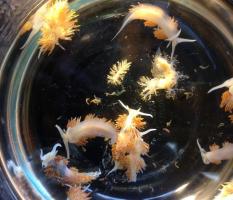
Marine sea slugs from a derelict Japanese vessel that washed ashore in Oregon. (John W. Chapman)
Since the Japanese tsunami of 2011 and the meltdown of the reactors at Fukushima, the Internet has been full of scary accounts of the Pacific Ocean becoming radioactive as well as stories of radioactive salmon and other fish. One widely repeated story said that Fukushima scientists have warned that fish in the Pacific Ocean will never again be safe for human consumption due to radioactive contamination. Another account claimed that radiation from the Fukushima disaster had caused 100% infant mortality among orca whales. There was even a story about mutated giant hornets from Fukushima killing people in Nebraska!
All of these accounts are urban legends, fake news — call them what you will — they are not true. Which is not to say that the US environment has not been impacted by the 2011 tsunami. A recent story in the Washinton Post describes how the tsunami brought a plethora of invasive species to the US West Coast, riding on the 5 million tons of debris swept into the ocean by the tsunami. Scientists have identified more than 280 species of organisms on the flotsam drifting ashore on the US West Coast.
The Post reports: No one could stop the flood, but the researchers could at least document it. The scientists created a network of volunteers in Hawaii and Alaska, down the Pacific Northwest to the middle of California. State and local officials, park rangers and legions of citizen scientists reported or bagged up what became known, in the biologists’ lingo, as JTMDs: Japanese tsunami marine debris. (None of the debris showed any traces of radiation, said James Carlton, a Williams College professor based in Mystic, Conn.)
The JTMDs ferried a lot of animals, as the scientists described in a paper published Thursday in the journal Science. During six years of study, from June 2012 to February, Carlton and his colleagues counted more than 280 species of Japanese hitchhikers on 600 pieces of debris. Most were spineless marine critters: sea stars, sea slugs, oysters, barnacles, mussels, amphipods, bryozoa and isopods. Only a few alien arrivals, two species of Japanese fish, had backbones.
Tsunami debris continues to wash up along the Pacific Northwest, most frequently following spring currents. Carlton said he expects the objects and their living cargo to arrive for the next 10 springs to come.
So while the tsunami has sent us invasive marine species at least most are invertebrates. So far, the tsunami and the Fukushima meltdown have not released a Godzilla-like monster on our shores, although I wouldn’t be surprised to read a post on the Internet suggesting it had.

Apples and oranges.
Scientists ‘breed’
terrifying red-eyed
mutant
wasps…because they
can
http://www.wired.co.uk/article/red-eye-wasp-mutant
Mutant Waspes have been in Asia.
World’s Biggest Hornet
Kills
Oct 4, 2013 … The Asian
giant hornet is wreaking
havoc in northwestern
China, … At 1.5 to 2 inches
(4 to 5 centimeters) long.
http://news.nationalgeographic.com/news/2013/10/131004-giant-hornet-insects-attacks-china-animals-science/
AND!
How many of us have a geiger counter to test the Asian food shipped into the USA?
Are we relying on our government to keep us safe, when they only check a fraction of the food entering the USA!